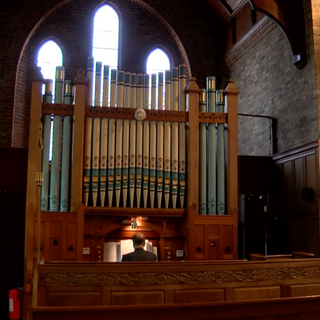Christ Church Cathedral: A Potted History
- Paula Fowmes
- May 31, 2017
- 3 min read
She’s one of those buildings; you pass her everyday and possibly don’t give her a second look because she’s always been there. She stands majestically over the town, dwarfing all else around her. She has appeared on stamps, paper money and postcards and she is iconic in the Falklands landscape, but Christ Church Cathedral is in dire need of help.
As 2017 marks a celebration for the Cathedral, it also marks doubt on the future of the building. The roof is leaking so badly in parts that it is effecting historic items inside. The bricks just inside the doorway are now patches of dust inbetween mortar. The repairs are estimated at over £450,000, and that’s if, once the roof is off, they find the beams have not rotted underneath.
In world terms, of course, Christ Church Cathedral finished in 1892, isn’t the oldest, but in a town built in only 1845 the Cathedral ties into the very history of Stanley and, by its location, is the World’s most southerly Anglican Cathedral.
At the start, Christ Church Cathedral was the mother church for the diocese of the Falkland Islands and South America, with the exception of British Guyana. Over the years, the size and shape of the diocese have changed, and the Falklands are now a parish in their own right and come directly under the jurisdiction of the Archbishop of Canterbury.
Once inside, you forget the history of the diocese and instead soak up the history of the people. Memorials and plaques line the walls, dedicated to the citizens of the Falklands and those who have made important sacrifices thoughout the islands history. The memorials tell their stories here to be remembered for as long as the Cathedral stands.
Mary Watson was the first district nurse in the Falkland Islands. She spent her days administering to the sick and infirm until her untimely death at just fifty three years old.
The community has refused to let her be forgotten and her memorial window fittingly features her at her bicyles as she was most often seen.
Even before the Cathedral was consecrated, one hundred and twenty five years ago, there was another church on this site.
There had been an Exchange building on the site with a central clock tower and two wings. The east wing was used as Holy Trinity Church, and the west wing was used variously over the years; as a school, and even as the residence of the Governor at one time. A new, purpose built Cathedral was proposed in the early 1880s, but in 1886 events unfolded that gave this project a new urgency.
A river of peat flowed down the hill on the night of the 2nd June. “A calamity, which might have had more fatal consequences,” says the Colonial Annual Report of 1886. The large peat bog at the back of town, saturated by the recent rainy weather, slid down the hill, filling lower parts of the houses on its way to the harbour, carrying away fences, outhouses and anything in its path. Two people were swept away and sadly suffocated. A large mass of the peat accumulated against the back wall of the Exchange building causing so much damage that the building was declared unsafe.
The Government donated the land and work began on the Cathedral. The original stones from the demolished Exchange building were used on the outer walls, and can still be seen today. The brickwork was added later, and hasn’t faired as well. The foundation stone was laid in 1890 and funds for the building works were raised through public donations both in the Falklands and the United Kingdom, including a donation of £30 from Queen Victoria.
The building was finally consecrated two years later, although it wasn’t quite finished at that point. Many of the fixtures and fittings of a working Cathedral were still missing.
The organ wasn’t installed until 1893 at a cost of £350 including shipping and installation. The organ is still inplace, just as it was when it was first played in January 1893. Behind the frontage is another hint of the stories the building has with scrawls and doodles of those who, out of sight, have worked pumping the bellows before it was converted to electricity.
The iconic sound of church bells wasn’t heard until 1905. The five bells in the tower were dedicated to George Markham Dean. As with the organ, bell ringers have been leaving their mark in the tower for over 100 years.
The Cathedral, at the moment, still stands tall over Stanley and her strong ties with the events and people of these islands will hopefully continue for years to come.




























Comments